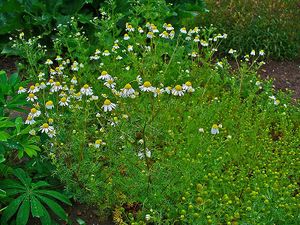Note: This is a project under development. The articles on this wiki are just being initiated and broadly incomplete. You can Help creating new pages.
Difference between revisions of "Matricaria recutita - Matricaria chamomilla"
Chaithrika (talk | contribs) |
Chaithrika (talk | contribs) |
||
| Line 16: | Line 16: | ||
<references> | <references> | ||
<ref name="Chamomile">[https://en.wikipedia.org/wiki/Chamomile"wikipedia"]</ref> | <ref name="Chamomile">[https://en.wikipedia.org/wiki/Chamomile"wikipedia"]</ref> | ||
| + | </references> | ||
== External links == | == External links == | ||
| Line 22: | Line 23: | ||
*[https://en.wikipedia.org/wiki/Matricaria "wikipedia"] | *[https://en.wikipedia.org/wiki/Matricaria "wikipedia"] | ||
| − | + | ||
Revision as of 10:57, 30 December 2016
Chamomile [1] or camomile is the common name for several daisy-like plants of the family Asteraceae that are commonly used to make herb infusions to serve various medicinal purposes.
MEDICAL USE OF CHAMOMILE
- German Chamomile has been used for treatment of inflammation associated with hemorrhoids when topically applied. There is level B evidence that German chamomile possesses anti-anxiety properties and could be used to treat stress and insomnia.
- Use the flower heads of this medicinal herb for infusions and salves to relieve indigestion and colic, anxiety and tension, and skin inflammations and irritations.
- Popular uses of chamomile preparations include treating hay fever, inflammation, muscle spasms, menstrual disorders, insomnia, ulcers, gastrointestinal disorders, and hemorrhoids.
